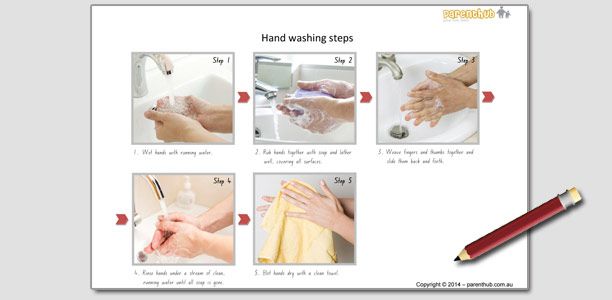Age
2.5-10 years
Duration of activity
This activity will probably take about 30 minutes.
Materials/equipment
- A4 paper for drawing or downloadable Hand washing steps pictures (for younger children who cannot yet draw)
- Pencils, felt pens or other colourful drawing tools
- Scissors
- Glue
- Ruler
Cost
This activity should not cost anything- you will probably already have all the things you need amongst your art and craft supplies.
Preparation
 For young children (4 years and younger) use the hand washing steps pictures instead of having them draw the pictures themselves. They can cut the pictures out and put them back in the correct order like a jigsaw puzzle.
For young children (4 years and younger) use the hand washing steps pictures instead of having them draw the pictures themselves. They can cut the pictures out and put them back in the correct order like a jigsaw puzzle.- For children aged 5-6 years, prepare the paper by ruling the lines to divide it into five evenly sized rectangles. You will need two pieces of paper divided into five evenly sized squares or download the template.
- Older children (aged 7 years and upwards) who are learning or able to use a ruler can do this themselves to practice ruling lines.
- Ensure you are familiar with the steps in the correct technique for hand washing with soap and water (wetting, applying soap, lathering soap, rinsing, drying hands, turning the tap off with a paper towel) so that you can help your child if they get stuck. See the answer sheet here.
What to do
Activity 1: Make hand washing posters with your child’s drawings (5-10 year olds)
- Explain to your child that you are going to make a hand washing poster that shows all the steps in the correct hand washing technique.
- Talk to your child about hand washing and what they need to do to wash their hands properly. It might be good to show them some other hand washing posters to help them remember the steps or to give them ideas for the drawing.
- Explain to your child that they will need to draw a picture to show what a child should do to wash their hands properly at each of the steps. Ask them what they will draw to show people the first step in the hand washing procedure.
 Ask your child to draw the first step in the hand washing procedure. Explain to them that they should draw it inside one of the rectangles on the paper. When they have finished drawing they will cut out their pictures and glue them to the other piece of paper. Encourage them to keep their drawing inside the lines so none of it gets chopped off.
Ask your child to draw the first step in the hand washing procedure. Explain to them that they should draw it inside one of the rectangles on the paper. When they have finished drawing they will cut out their pictures and glue them to the other piece of paper. Encourage them to keep their drawing inside the lines so none of it gets chopped off.- When your child has finished drawing the first step, talk to them about what they have drawn, for example what the person in the picture is doing and why this is an important step in the hand washing procedure.
- Repeat until your child has drawn all the steps in the hand washing procedure.
- When the pictures are drawn, ask your child to cut out their boxes neatly with scissors.
- Next ask them to glue the pictures to the hand washing poster in the correct order.
- When the poster has dried, hang it in the bathroom or another hand washing area to remind everyone to wash their hands.
Activity 2: Make hand washing posters with template pictures (2-4 year olds)
- Tell your child that you are going to make a poster about hand washing that shows children all the steps they need to take to wash their hands properly.
- Have a chat about hand washing and what they need to do to wash their hands properly. It might be fun to go and wash your hands and talk about all the things they had to do.
- Show them the template pictures of the hand washing steps and ask them what the person is doing in each step.
 Ask your child to cut out the boxes around each picture- even two year olds will enjoy having a go at cutting but they probably won’t get much further than snipping at the edges of the paper. So encourage them to have a try but be ready to help them when they’ve had enough. It might also be a good idea to print a couple of sets of pictures in case your child’s little hands accidently cut a picture or two in half.
Ask your child to cut out the boxes around each picture- even two year olds will enjoy having a go at cutting but they probably won’t get much further than snipping at the edges of the paper. So encourage them to have a try but be ready to help them when they’ve had enough. It might also be a good idea to print a couple of sets of pictures in case your child’s little hands accidently cut a picture or two in half.- When all the pictures are cut out, show your child the poster template (six evenly sized squares in which the pictures will be stuck) and explain to them that to make the poster they need to stick one picture in each box, but they must stick the pictures in the correct order.
- Ask your child to identify the first step in the hand washing procedure. Talk about what the step involves and then place the picture over the first box of the poster template.
- Repeat for the remaining pictures then glue all the pictures in their correct places.
- Allow the glue to dry and then hang the poster in the bathroom or another place where children wash their hands. Place it at your child’s eye level so they can’t miss it.
Tips
- As you make the hand washing poster talk to your child about why hand washing is important and the times when children should wash their hands (e.g. after playing outside).
- Talk about when adults should wash their hands, and how the important times for hand washing differ for people working in different occupations. For example, doctors and nurses must wash their hands before and after touching patients, a farmer must wash their hands after touching animals or soil and a mother or father must wash their hands after changing a baby’s nappy and before preparing food.
Extension activities
- Instead of gluing the squares your child has drawn onto a poster, laminate them and use them like piece of a jigsaw. Your child can then practice putting them together in the correct order.
- If your child is already familiar with numbers, get them to write the numbers 1-6 on their hand washing technique pictures.
- For older children get some extra mathematics practice by measuring the size of the boxes and pictures with a ruler when you have finished making the poster.
Educational outcomes
Self care skills
 Hand washing is one of the most important hygiene practice children can learn as washing their hands properly and at appropriate times is a key way of avoiding infection with diseases like cold and flu. Children start washing their own hands (with help and plenty of reminders) at about 2-3 years of age. By the end of preschool most children will already know how to wash their hands and that they need to do it, for example after going to the toilet and before eating. Making the hand washing poster can reinforce what they already know about washing their hands. When the hand washing poster is hung in the bathroom or another hand washing area it will help remind children that they need to wash their hands.
Hand washing is one of the most important hygiene practice children can learn as washing their hands properly and at appropriate times is a key way of avoiding infection with diseases like cold and flu. Children start washing their own hands (with help and plenty of reminders) at about 2-3 years of age. By the end of preschool most children will already know how to wash their hands and that they need to do it, for example after going to the toilet and before eating. Making the hand washing poster can reinforce what they already know about washing their hands. When the hand washing poster is hung in the bathroom or another hand washing area it will help remind children that they need to wash their hands.
Fine motor skills
Writing and drawing are important skills for children to learn and they rely heavily on their fine motor skills, that is, their ability to use their fingers to manipulate objects like a pencil. Every time your child practices writing and drawing they are further developing the muscles in their fingers and their ability to control their finger movements. Most four year olds will be starting to grip their pencil properly, but may still sometimes try to hold it in their fist or change their pencil grip sometimes. They may also change between using their left and right hands (although they should already be showing a preference for either left or right). By early primary school children generally have a well developed pencil grasp, consistently use either their left or right hand and should be starting to write letters and numbers correctly. Older children should be able to write with ease and use associated tools for example a ruler to measure the lines they have drawn.
The cutting and pasting parts of this activity will also help children develop fine motor skills. Two year olds will probably love trying to use the scissors but won’t be able to cut much- expect them to make just a snip or two at the edges of the paper and to have difficulty holding the scissors (e.g. try to hold them using two hands because they struggle to get them open and closed with one hand). Three year olds are generally developing the ability to control and manipulate scissors with just one hand (but might go back to using two hands from time to time). Although they’ll be able to open and close the scissors, they probably won’t yet be able to cut in a straight line. By four years of age most children can hold a pair of scissors correctly and cut straight lines like the squares for the hand washing pictures. However at this age it’s common for kids to leave a margin around the shape they are cutting.
Kids should also be able to spread paste or use a glue stick from about four years of age. Younger children will enjoy dolloping and spreading paste on the paper using their fingers. But be ready for a bit of a mess- they’ll probably use more glue than they need to and spread it on more than the paper.
Mathematical skills
Sequence, or the idea that some things come before and others after, is an important mathematical concept. Thinking about the sequence of hand washing steps is a great way for children to develop their understanding of sequence.
Writing numbers on the hand washing pictures will help children learn to recognise and understand the meaning of numerals, for example that 1 is a numeral that represents a single object or the first step in a sequence. Recognising and being able to write numerals is an important foundation for future mathematical learning- children will not be able to do maths tasks like addition and subtraction unless they can read and write numbers. Young children (e.g. 2-4 year olds) may not yet recognise the numbers but they’ll benefit from counting the hand washing steps (and seeing the numbers written on them as they count).
 Older children who use a ruler to draw the boxes also get the opportunity to learn about measurement. For younger children this might involve comparing the size (e.g. bigger, smaller, same) and most children can correctly use these mathematical terms to describe the relative size of an object by the time they are four years old. They may even throw in measurement words like metres or centimetres, but at this age they won’t understand them. By about eight years of age children should understand standard units of measurement like centimetres. They should be able to accurately measure objects like the hand washing picture squares with a ruler.
Older children who use a ruler to draw the boxes also get the opportunity to learn about measurement. For younger children this might involve comparing the size (e.g. bigger, smaller, same) and most children can correctly use these mathematical terms to describe the relative size of an object by the time they are four years old. They may even throw in measurement words like metres or centimetres, but at this age they won’t understand them. By about eight years of age children should understand standard units of measurement like centimetres. They should be able to accurately measure objects like the hand washing picture squares with a ruler.
Social and communication skills
Children’s social and communication skills develop every time they socialise and communicate. And they’ll be socialising and communicating with you as they do this activity. Speak to them in clear, simple sentences, using words which are appropriate for their age. Model the rules of conversation, for example listening when you are spoken to and answering when you are asked a question, and remind your child to do the same. Older children will have better developed communication skills, for example they’ll improve their ability to communicate their thoughts and feelings by varying the language they use and their tone of voice. They’ll also be experimenting with different types of body language and facial expression and how these can be used to communicate.
Printables download
- Hand washing steps pictures (for younger children who cannot yet draw)
- Hand washing poster template
- Hand washing procedure – answer sheet
More hand washing games and activities.
References
- Virginia Early Childhood Development Alignment Program. Milestones of child development- A guide to young children’s learning and development from birth to kindergarten. 2009. (cited 26 July 2013). Available from: (URL Link)
- Centre for Innovation in Education. Numeral Writing. 2011. (Cited 28 May 2014). Available from: (URL Link)
- Abraham C. Curriculum ideas for exploring hand washing. 2005. (cited 29 May 2014). Available from: (URL Link)
- Australian Curriculum and Reporting Authority. Australian Curriculum- Mathematics. Undated. (cited 29 May 2014). Available from (URL Link)
- South Australian Health Infection Prevention and Control. Hand Hygiene Guideline. 2010. (cited 29 May 2014). Available from: (URL Link)
- Columbus Public Health. Teaching hand washing to young children. 2012. (cited 29 May 2014). Available from: (URL Link)
- Australian Curriculum and Reporting Authority. Australian Curriculum- English. Undated. (cited 29 May 2014). Available from: (URL Link)
- Andrews M. General Categories of Fine Motor Development. Michigan State University Extension. UNDATED. (cited 28 March 2014). Available from: (URL Link)
- South Carolina Education Office of Early Childhood Education. Good Start Grow Smart- South Carolina Early Learning Standards for 3, 4 and 5 year old children. 2007. (cited 20 February 2015) Available From: (URL Link)



 (9 votes, average: 4.56 out of 5)
(9 votes, average: 4.56 out of 5) 







